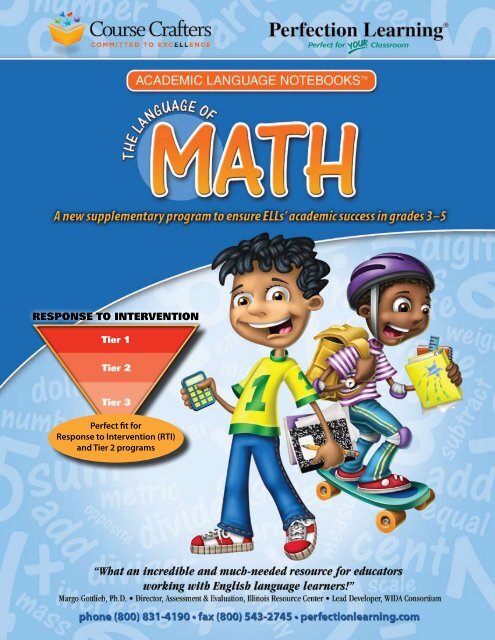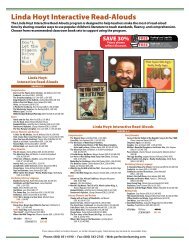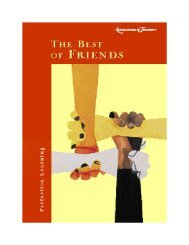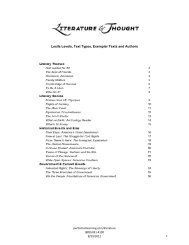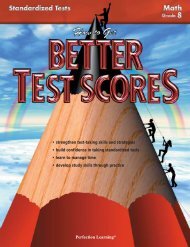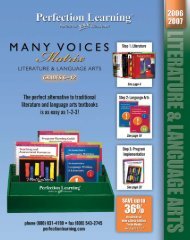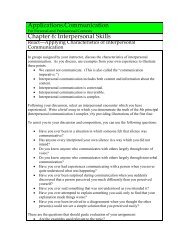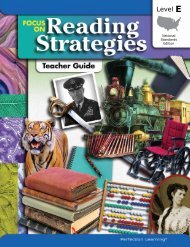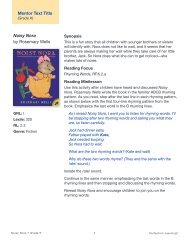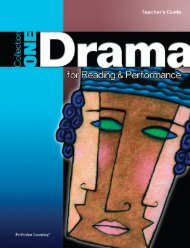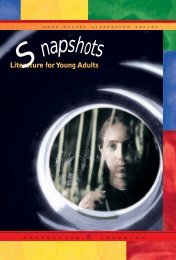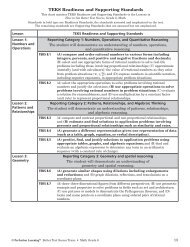Tier 1 Tier 2 Tier 3 - Perfection Learning
Tier 1 Tier 2 Tier 3 - Perfection Learning
Tier 1 Tier 2 Tier 3 - Perfection Learning
- No tags were found...
You also want an ePaper? Increase the reach of your titles
YUMPU automatically turns print PDFs into web optimized ePapers that Google loves.
What is Academic Language?Academic English is the language ELLs need in order to succeed in academic settings.Academic English differs from the social English that students use to carry on conversationsabout everyday situations. Academic language is needed to understand, talk, and writeabout abstract, decontextualized concepts. It is crucial for understanding textbooks, solvingproblems, and doing well on standardized tests. Without explicit and frequent attention to theacademic language of mathematics, ELLs will not have the academic language skills needed tosucceed in mainstream math classes.The academic language of math includes vocabulary, both specialized math vocabularyand everyday words with additional math meanings (such as volume, carry, or plane). It alsoincludes grammar, such as translating word order into mathematical symbols (the sentence“The number a is 5 less than the number b” isn’t a = 5–b, but a = b–5), and language use, such asknowing how to explain a mathematical process.Teaching Academic Vocabulary• Make the meanings of words explicit and clear. Demonstrate meaning throughvisuals, examples, and contextualized activities before introducing formal definitions.• Actively involve students in vocabulary learning by linking meaningful, hands-onactivities with vocabulary learning. Puzzles and games are helpful for gettingstudents to use the vocabulary in sentences, and for relating the words to the maththey are learning.• Expose students to vocabulary as much as possible, as many times as possible.ELLs need multiple repetitions in different contexts in order to gain a deep understandingof new terms. Repeat the vocabulary as much as you can, in as many meaningful waysas possible.Teaching Academic Grammar• Introduce grammar points in context. Provide multiple examples in contextsthat students are familiar with. Point out how the language works, but do not giveextensive grammatical explanations.• Focus on grammar throughout a math lesson. Call students’ attention to how you usea grammar point while you are teaching math. Provide activities where studentshave to use the language while they are doing math.• Do not correct students’ grammar mistakes. Instead, model the correct structure byrephrasing what students say when you respond to them.2 • What is Academic Language?
Works with All Math TextsWorks in All ClassroomsHow Does the Program Complement theCore Math Curriculum?The Academic Language Notebooks: The Language of Math supportand enhance any math textbook.Each grade level includes 30 modules. The modules directly support the key mathtopics in best-selling grades 3, 4, and 5 math textbooks and zero in on the mostessential vocabulary, grammar, and sentence-level language of math for ELLs.Correlation charts that indicate how and where the modules complement aspecific math textbook program or set of standards will be available to schoolsadopting the Academic Language Notebooks.The Academic Language Notebooks are modular and the modules don’t need to beused in sequence. With this built-in flexibility, teachers can select and use themodule they need, when they need it, for their ELLs.How Does the Program Fit DifferentClassroom Models?1 2Mainstream AcademicClassrooms• Non-sequential, topic-basedmodules that easily plug into thegrades 3–5 curriculum• Direct support of grade-level mathcurriculum and textbooks to ensurefocus on the academic languageELLs need to succeed in the regularclassroomESL and StructuredEnglish Immersion Programs• Comprehensive scope of essentialacademic language, as identifiedby research• Combination of performance-basedand standardized assessments tomeasure and support learning—on the lesson level and throughoutthe school year“The Academic LanguageNotebooks are explicit anduser-friendly and the lessonsare visually engaging and clear.This is the supplementalacademic English instructionseries we’ve been looking for toassist staff in our high intensity,pull-out, and integrated modelsof Structured English Immersion.”Graciela Trilla, Ed.D.Supervisor of EnglishLearner EducationHaverhill Public SchoolsHaverhill, MADesigned specifically forEnglish language learnersand their teachers,Academic LanguageNotebooks (ALN)were created for themultiple program modelsin which ELLs are enrolledacross the country.3 4Bilingual EducationPrograms• Visual presentation of content accessesstudents’ background knowledgefirst and connects what they know tolearning academic English• English-Spanish glossary and list ofcognates leverages Spanish-speakingstudents’ native language to help themtransfer math knowledge into EnglishAfter School andSummer Programs• Built-in professional development,including models of comprehensible“teacher talk,” makes the programeasy to implement for inexperiencedteachers, aides, and tutors• Interactive, engaging activitiesmotivate students to review essentialmath concepts while buildingacademic languageWorks with All Math Textbooks •3
Program MaterialsExceptional Support for ELLs and Their TeachersStudent <strong>Learning</strong> SystemarrayExplainDrawModule 7Level D✂ExampleNotesStudent Worktext• 30 modules per book• 4 lessons per module—Understand the Main Idea—Learn the Vocabulary—Use More Language—Solve Math Problems• Glossary of key wordsStudent Management System• 3-ring binder• Notebook paper• Tabs for organizing lessons✂Explain DrawExample NotesStudent Vocabulary Cards• encourage meaningful, personalizedvocabulary learning and recall• space for students to write examples fromtheir math textbooks, make notes, createtheir own definition, and draw• 200 vocabulary cards per grade level,including blank cards for teacher useModule 7equal groups© Copyrighted Material – Reproduction Permitted. © Copyrighted Material – Reproduction Permitted.Level D4 • Program Materials
All of the materials in the easy-to-use Academic Language Notebooks (ALN)program support ELLs’ success—and their teachers’ success, too.Teacher ToolKitTeacher/Tutor Resource Book• Designed for use by all teachers, tutors, and aides—even those with little or no experience with thesestudents• Six research-based ELL Best Practices are translatedinto effective instruction on a daily basis• All lessons follow a single, predictable format:Introduce, Teach and Learn, Review and Practice,and Assess and InterveneTeacher Transparencies• Easy-to-use tool for introducing and modeling lessonmaterial to a group or class• Reproduce important illustrations, charts, diagrams,and other teaching aides from the Student Worktextand Teacher/Tutor Resource Book• Two transparencies to support every module—60 per gradeAssessment Handbook• Guidelines for assessing ELLs using ALN• Lesson-Level Assessment Rubrics: Rubrics from theTeacher/Tutor Resource Book lessons in a handyreproducible form to assess and record individualstudent progressTeacher Resource CD-ROMA rich collection of management and planning tools,assessments, extra activities, and resources for teachersusing the ALN math program.Assessment Management SystemAn easy-to-use technology-based system for tracking ELLs’performance within ALN, managing student assessmentdata, helping to measure Adequate Yearly Progress, andtargeting additional support needed for each learner.• Track individual student performance and progress atthe lesson level over time• Identify areas of individual challenge• Target further intervention needed by each student• Compare individuals, classes, and schools• Sort by student, class, grade, and English languageproficiency levelExtra Practice Worksheets• 30 per grade—one per module• In pdf form on the CD-ROM for easy printingby the teacherAdditional Resources• Suggestions for lots of fun books, web math games,manipulatives, and helpful materials for studentsand teachers• Flashcards, lesson plans, tests, problems of the day,and much moreImplementation Guide• Chart summarizing language, concepts, prerequisiteknowledge, and materials required in every lesson• Handy tool for teacher planning, distilling mostimportant information on scope and activities ofindividual lessons• Correlation to math standardsELL Best Practices Audio CDPortable professional development —an audio recordingof the six ELL Best Practices to listen to while in the car,at home, or at school. Takes research and turns it intoactual techniques to use in your classroom.Program Materials •5
The Teacher/Tutor Resource BookTranslates ELL Best Practices into Effective InstructionThe Teacher/Tutor Resource Book (TTRB) is designed for all ELL teachers, tutors, and aides—even those with little or no experience with these students. Through the use of six research-basedELL Best Practices, professional development is built into every lesson. All lessons follow a simple,predictable format: Introduce, Teach and Learn; Review and Practice; and Assess and Intervene.TTRB Lesson One: Understand the Main Idea1. Before teachers begin, they knowhow long the lesson will take, when to teachthe material in relation to the core mathtextbook and the Student Worktext, and whatmaterials will be needed.2. Six ELL Best Practices are integratedthroughout the TTRB. Best Practice 1,Comprehensible Language, is featured in thisgrade 4 module on estimation.3. Teachers are alerted to themathematical concepts andacademic language ELLs need to knowto be successful in the module.4. Words and phrases that mayaffect comprehension, and astudent’s ability to get the correctanswer, are highlighted on eachreduced Student Worktext page.5. Language support is provided where appropriatefor Spanish-speaking students during the lessons.Support is also provided in the Student Worktext in theglossary where English and Spanish words are listed.A list of Spanish/English cognates is also included.6. Each lesson includes a rubricthat uses specific tasks from thePractice Activity to allow teachersto evaluate students’ performance.6 • The Teacher/Tutor Resource Book
With the support of the Teacher/Tutor Resource Book (TTRB), all ELL educatorswill learn to integrate research-based ELL strategies into daily instruction.TTRB Lesson Two: Learn the Vocabulary1. Teachers encourage studentsto connect what they knowabout the topic to what they’llbe learning.2. Essential Vocabulary is explicitly taughtduring the lesson. Some students may need helpwith Additional Vocabulary related to the mathtopic. More activities to teach vocabulary areincluded in the TTRB.“This is a wonderful programthat will benefit students as wellas teachers. Teachers and tutorswill now have appropriatematerials to teach studentsthe vocabulary and languagethey need to function in themainstream math classroom.The presentation is focused,functional, and concrete.”Ellen BallaELL and Basic Skills Teacher, K–6Simsbury (Ct.) Public Schools3. Essential Vocabulary isintroduced and taught orally andcontextually, by making frequentuse of visuals and manipulatives.4. Other core program components,such as vocabulary cards andtransparencies, are integrated inthe lesson plan at point-of-use.5. Intervention providesspecific suggestions and easyto-implementextra practicefor students who need it.The Teacher/Tutor Resource Book •7
Carefully-Crafted Lesson PlansStrong, Effective Teacher SupportEach Teacher/Tutor Resource Book (TTRB) lesson plan provides suggestions fordifferentiating instruction with intermediate and advanced ELLs in grades 3–5.The TTRB also features guidelines for assessment and intervention in every lesson,and extension and enrichment activities in every module.TTRB Lesson Three: Use More Language1. ELLs use and build background knowledge bytransforming words or pictures in their math textbook lessonabout estimation and using language they already know.2. Ease of use by the teacher is key.All reduced Student Worktext pages inthe TTRB include answers.3. During Review and Practice,students work in small groupsor pairs and teachers circulateto check and assess progress.4. Assessment rubrics in each lessonmake it easy for teachers to determineif students have achieved the objective,and which learners could benefitfrom intervention.8 • Carefully-Crafted Lesson Plans
In each Teacher/Tutor Resource Book (TTRB) lesson plan, teachers get step-by-stepguidance on how to introduce, teach, and help ELLs practice and use academic language.TTRB Lesson Four: Solve Math Problems1. Teachers use the final lesson in themodule after the grade-level math class,and before students complete the Solve MathProblems lesson in their Student Worktext.2. In Extension and Enrichment,hands-on activities encourageproficient students to use and applywhat they’ve learned.3. As teachers do the Think Aloud,students hear academic languageand polish their listening andproblem-solving skills.4. Worksheets provideopportunities forextra, structuredpractice with difficultconcepts and language.5. Intervention activities provide direct supportin reteaching the most difficult languageor content. In the Intervention for this lesson,the problem is not likely to be language, butdetermining an estimate or approximate answer.Carefully-Crafted Lesson Plans •9
The Student WorktextFocused on Building ELLs’ Academic SuccessBuilds Math Background and Academic LanguageThe unique Student Worktext—one per grade level—is at the core of theAcademic Language Notebooks (ALN) program. These engaging, interactive materialsbuild background knowledge, model correct academic language usage, andencourage lots of language practice.Each of the 30 modules in the Student Worktext includes four lessons:Lesson 1:Understand the Main Idea1. Objectives tellstudents in easyto-understandlanguage whatthey’ll be able to doafter completingeach lesson.3. The writtenMain Idea explicitlystates the criticalmath conceptsfor the module incomprehensiblelanguage.4. Practice Applying theMain Idea makes sure studentsunderstand the critical mathconcepts and can apply what theyknow about the main idea.2. Charactersuse language inreal-life contexts,providing models ofacademic languageuse for students.Lesson 2:Learn the Vocabulary1. Chartscontextualize theacademic vocabularyand provide visualdefinitions of mathconcepts.2. Clear definitionsfor all EssentialVocabulary areprovided in thelessons and in theglossary at the backof the StudentWorktext.4. Students are challengedto use academic vocabularyto create complete sentences.3. Practice the Wordschecks students’understanding ofvocabulary neededto meet lessonobjectives.10 • The Student Worktext
The engaging Student Worktext develops the academic language ELLs needto understand and accomplish grade-level math work.Prepares ELLs for Math Class, Textbooks, and TestsThe modules in the grades 3, 4, and 5 Student Worktexts correspond to grade-leveltopics in the math curriculum and math textbooks. Each of the modules zeros in onthe most difficult academic language of the topic, helping students prepare for classwork and tests.1. Students practiceand use languageand math conceptsthrough activitiesthat motivate andengage.3. Studentsdemonstrateunderstanding ofacademic languageand concepts byanswering questionsusing data.Lesson 3:Use More Language2. ELLs learn better iflearning objectivesare clear andachievable. Lessonobjectives are sharedfrequently withstudents, in oral andwritten form.Lesson 4:Solve Math Problems1. ELLs useproblem-solvingstrategies and solvemath problems todemonstrate theirunderstanding ofthe topic.2. Learn to SolveProblems modelsthe thinkingprocess and thelanguage studentsneed to completeeach step of theproblem.3. ELLs solve grade-level-appropriateword problems to demonstrate knowledge andunderstanding. To answer, they use sentencelevellanguage they’ve learned in the module.The Student Worktext •11
Teacher Resource CD-ROM.AssessmentTracking Student Progress in ALNHow to Use Assessment Informationfrom ALNThe modules represent grade-level topics in math curriculum andsummative tests.Assessment for each lesson provides• ongoing formative information for teachers• information to show how assessment is integrated intoinstruction• immediate feedback that enables teachers to instantaneouslyuse the results before moving on to the next lessonTracking Student ProgressManually• Student progress can be tracked on paper by using theIndividual and Class Year-to-Date Performance Reports in theback of the Assessment Handbook.Electronically• Student progress can be tracked electronically by using theAssessment Management System included on the TeacherResource CD-ROM.INDIVIDUAL YEAR-TO-DATE PERFORMANCE REPORT, MODULES 1-15Use these forms to track the individual progress of students in your classroom:1. Enter the results of assessments at the end of every lesson in columns 1–4.2. Calculate the average scores of all four lessons to get the module average in column 5.3. Enter semester and year-long averages in the last lines of both forms.This form can also be completed electronically by using the ALN Assessment Management System on theLesson 1:Lesson 2:Module Understand the Learn theNumber Main Idea Vocabulary122 • Individual Year-to-Date Performance Report, Modules 1-15Lesson 3:Lesson 4:Use MoreSolve MathLanguage Problems Module Averageout of out of ____ out of out of ____ Example __ 2 out of __ 4 = ___ 50% __ 3 out of __ 4 = 75% ____ ___ __ 2 out of __ 2 = ____ 100% ____ ____ = ____%__ 2 out of __ 3 = ___ 67% ____ ____ = ____%__ 9 out of __ 11 = 82% _______ = ____%____ = ____%____ out of ____ out of ____ ____ out of ____ ____ out of ____ ____ out of ____= ____%= ____%____ out of ____ ____ out of ____ = ____%= ____%= ____%____ out of ____ ____ out of ____ ____ out of ____= ____%= ____%____ out of ____ ____ out of ____ = ____%= ____%= ____%____ out of ____ ____ out of ____ ____ out of ____= ____%= ____%____ out of ____ ____ out of ____ = ____%= ____%= ____%____ out of ____ ____ out of ____ ____ out of ____= ____%= ____%____ out of ____ ____ out of ____ = ____%= ____%= ____%____ out of ____ ____ out of ____ ____ out of ____= ____%= ____%____ out of ____ ____ out of ____ = ____%= ____%= ____%____ out of ____ ____ out of ____ ____ out of ____= ____%= ____%____ out of ____ ____ out of ____ = ____%= ____%= ____%____ out of ____ ____ out of ____ ____ out of ____= ____%= ____%____ out of ____ ____ out of ____ = ____%= ____%= ____%____ out of ____ ____ out of ____ ____ out of ____= ____%= ____%____ out of ____ ____ out of ____ = ____%= ____%= ____%____ out of ____ ____ out of ____ ____ out of ____= ____%= ____%____ out of ____ ____ out of ____ = ____%= ____%= ____%____ out of ____ ____ out of ____ ____ out of ____= ____%= ____%____ out of ____ ____ out of ____ = ____%= ____%= ____%____ out of ____ ____ out of ____ ____ out of ____= ____%= ____%____ out of ____ ____ out of ____ = ____%= ____%= ____%____ out of ____ ____ out of ____ ____ out of ____= ____%= ____%____ out of ____ ____ out of ____ = ____%= ____%= ____%____ out of ____ ____ out of ____ ____ out of ____= ____%= ____%= ____%____ out of ____ ____ out of ____ = ____%= ____%Overall= ____%____ out of ____ ____ out of ____= ____%Averages = ____%(Modules Lesson 1:____ out of ____ = ____%____ out of ____ Lesson 2:____ out of ____= ____%1-15) = ____%____ out of ____ Lesson 3:= ____%= ____%____ out of ____ Lesson 4: = ____%____ out of ____ All Lessons:= ____%____ out of ____= ____%123456789101112131415© Copyrighted Material – Reproduction Permitted.14 • Assessment
Grade 3 (Level C)Program ScopeModule Numberand NamePrerequisiteBackgroundKnowledgeLesson 1:Understand theMain IdeaLesson 2:Learn theVocabularyLesson 3:Use MoreLanguageLesson 4:Solve MathProblems1. Place Value • Ability to count to 100in English• Understanding ofgroups of 10 andgroups of 100You can use place value toread and write numbersand to tell the values ofdigits in numbers.• number• digit• value• place• place valueUse correct pronunciationto give and respond tocommands about readingand writing numbers.Make a list to helpunderstand the question.2. Compare andOrder WholeNumbers• Basic understanding ofplace value• Ability to use base tenblocks and numberlinesYou can compare andorder whole numbers indifferent ways.• to compare• to order• greater than• less than• equal to• not equal toUse comparative andsuperlative adjectives tocompare and orderwhole numbers.Identify what informationyou know and what youneed to find out in aword problem.3. Round WholeNumbers• Comparative terms(greater than,less than)• Place names (tens,hundreds, thousands)You can use number linesor rules to roundwhole numbers.• to round/rounds• rounding place• about• increase• halfway betweenUse comparative andsuperlative adjectives(closer, closest, nearer,nearest) to ask and answerquestions about rounding.Understand questionswith or.4. Count Moneyand Make Change• Number words• Names and values ofU.S. coinsYou can count coins andbills to tell how muchsomething costs and tomake change.• dollar• dollar sign• cent• cent sign• decimal point• bill• coinUse regular and irregularpast tense verbs todescribe how muchsomething costs and howmuch change was given.Use play money to helpunderstand a multi-stepproblem.5. Addition andSubtractionBasic ConceptsBasic concepts of additionand subtractionProperties can help youunderstand addition.Fact families can helpyou understand howaddition and subtractionare related.• addend• sum• difference• fact family• inverse (opposite)operations• propertyCreate similes toremember names ofproperties.Use drawings or countersto make sure that cluewords can help you solvea problem.6. Estimate Additionand Subtraction• Basic concepts andvocabulary of additionand subtraction• RoundingWhen you estimate, youuse numbers that are easyto add and subtract inyour head.• to estimate/an estimate• exact answer• reasonableUse because to explainwhy you used a particularmethod of estimation.Use clue words to decidewhether to estimate orfind an exact answer.7. Addition andSubtraction withRegrouping• Basic concepts andvocabulary of additionand subtraction• Place names andvaluesSometimes when you addor subtract, you have tobreak numbers apart andregroup them.• to break apart• to regroup 1 ten/hundred/ thousand as(into) 10 ones/ tens/hundreds• enoughUse when clauses toexplain when you need toregroup.Write a number sentencein the correct order whensubtracting.8. MultiplicationConcepts• Basic concepts ofadditionWhen you multiply, it isthe same as when you addequal groups.• times• equal groups• repeated addition• array• Commutative (Order)Property of Multiplication• product• factorUse each to ask andanswer questions aboutequal groups.Use clue words and equalgroups to choose thecorrect operation.16 • Grade 3—Program Scope
Module Numberand NamePrerequisiteBackgroundKnowledgeLesson 1:Understand theMain IdeaLesson 2:Learn theVocabularyLesson 3:Use MoreLanguageLesson 4:Solve MathProblems9. MultiplicationFacts• Basic multiplicationconcepts andvocabulary• Skip counting patternsThere are many differentways to find products.• doubles/ doubling• skip counting• pattern• breaking apart• Identity Property ofMultiplication• Zero Property ofMultiplicationUse because to explainhow using a specific wayof doing multiplicationmade it easier to multiply.Understand how toexplain “How do youknow?” questions.10. DivisionConcepts• Basic concepts ofsubtractionWhen you divide, it isthe same as when yousubtract equal groups orshare equally.• divided by• repeated subtraction• to separate• to share equally• dividend• divisor• quotientUse word order andwriting order to correctlyread and write differentforms of divisionproblems.Use in and of to decidewhether to find thenumber of groups or thenumber in a group in adivision word problem.11. Relation ofMultiplicationand Division• Basic conceptsand vocabulary ofmultiplicationDivision is the opposite ofmultiplication.• opposite• related factUse divide by andmultiply by to describefact families.Write a multiplicationproblem and a divisionproblem that both use thesame fact family.12. Division Facts • Multiplication facts• Basic division conceptsand vocabularyThere are many differentways to find quotients.• division rules• repeated subtraction• multiplication tableUse if clauses to tell whenyou can use different waysto find quotients.Write a number sentenceto help understandquestions in wordproblems.13. LinearMeasurement(Customaryand Metric)• Concept andvocabulary ofestimation• Understanding ofmultiplication anddivisionWe use units of lengthto measure how longsomething is.• to measure/measurement• unit• standard• customary• metricUse units of length(customary and metric) todescribe measuring andchanging from one unit toanother (within systems).Choose the appropriateunit of measurementto solve word problemsinvolving length andwidth.14. Measurementof Capacityand Weight(Customaryand Metric)• Concept of standardunits of measurement• Understanding ofmultiplication anddivisionYou can use customary ormetric units to measurehow much somethingholds and how muchweight or mass it has.• capacity• container• to contain• weight• massUse units of capacityand weight or mass(customary and metric) todescribe measuring andchanging from one unit toanother (within systems).Choose the appropriateunit of measurementto solve word problemsinvolving capacity andweight.15. Clock Time • Read and writenumber words• Skip count by fives• Concepts of half andquarterWhen you know how totell time, you can find outhow long something lasts.• to tell time• elapsed time• noon• midnight• a.m.• p.m.Use does and presenttense verbs to ask andanswer questions abouttelling time and elapsedtime.Use clue words to decidewhen you have to findelapsed time.Grade 3—Program Scope •17
Grade 3 (Level C) (continued)Program ScopeModule Numberand NamePrerequisiteBackgroundKnowledgeLesson 1:Understand theMain IdeaLesson 2:Learn theVocabularyLesson 3:Use MoreLanguageLesson 4:Solve MathProblems16. Calendar Time • Names of days of theweek• Names of months ofthe yearYou can use a calendar toorganize time into days,weeks, and months.• calendar• date• year• ordinal numbersUse did and past tenseverbs to ask and answerquestions about whenthings happened in thepast.Use real worldinformation to solveproblems.17. Temperature • Concept that the samething can be measuredwith different unitsYou can measuretemperature with athermometer.• temperature• thermometer• degrees Fahrenheit• degrees Celsius• scaleUse synonyms, antonyms,and adjectives of degreeto describe temperatures.Identify unnecessaryinformation in a wordproblem.18. Collect andOrganize Data• Concepts andvocabulary forcomparing andordering numbers• Skip counting by fivesWhen you collect data,you can organize it indifferent ways.• data• survey• range• mode• tally chart (table)• line plotDistinguish mathematicalmeanings of words fromother meanings.Understand questionsabout comparisons.19. Read andMake Graphs• Skip counting tomultiply or divideDifferent kinds of graphsshow and compare data indifferent ways.• graph• title• label• key• symbolUse comparative andsuperlative suffixes (-er,-est) to ask and answerquestions about data ongraphs.Understand hypotheticalquestions withif …would in wordproblems.20. Lines,Line Segments,Rays, andAngles• The concept thatthings can bemeasured in differentwaysWe can use lines andangles to describe objects.• line• angle• degree• endpoint• square cornerUse pictures to formulatedefinitions of geometricterms.Use definitions anddrawings to answerquestions that ask you toexplain about geometricfigures.21. Plane Figures • Concepts of lines andangles; names ofangles (right, acute,obtuse)• Concept of patternYou can classify planefigures in different ways.• plane figure• to classify• closed figure• open figure• polygonUse classification to helplearn names of polygons.Look for and describepatterns to decide whatcomes next in a sequence.22. Congruence,Symmetry, andTransformations• Names of polygons• Concept of patternYou can move shapes tosee if they are the same,or fold them to see if thetwo sides match.• congruent• symmetry• line of symmetry• symmetric• similarUse commands, presenttense sentences, andnouns to show that slide,turn, and flip can benaming words or actionwords.Decide when to explainyour answer to a question.23. Solid Figures • Names of plane figures You can describe somesolid figures by tellingabout their parts.• solid figure• face• edge• vertex/verticesUse is shaped like and thenames of everyday objectsto describe solid figures.Use what you know tosolve problems withunknown words.18 • Grade 3—Program Scope
Module Numberand NamePrerequisiteBackgroundKnowledgeLesson 1:Understand theMain IdeaLesson 2:Learn theVocabularyLesson 3:Use MoreLanguageLesson 4:Solve MathProblems24. Perimeter,Area, andVolume• Basic concepts of planeand solid figures,measurement, andestimationYou can measure thedistance around a planefigure, and the spaceinside a plane figure or asolid figure.• perimeter• unit• area• square unit• volume• cubic unitUse should to recommendhow much materialsomebody needs to buy(with relation to perimeter,area, and volume).Take long sentences apartto understand them.25. FractionConcepts• Concept of divisioninto partsA fraction is a numberthat names part of awhole or part of a group.• fraction• whole (region)• group (set)• numerator• denominator• equal partsUse is and are in questionsabout fractions.Draw a picture of a wholeor a set and show thefractional parts in order tosolve the problem.26. EquivalentFractions;Compare andOrder Fractions• Concepts andvocabulary ofcomparing andordering wholenumbersThere are different waysto find fractions thatname the same amount.There are different waysto compare and orderfractions.• equivalent fractionUse that clauses todescribe equivalentfractions and compareand order fractions.Understand questionswith if.27. Decimals • Basic concepts ofplace value andfractional partsYou can use decimals toshow fractional parts ofa whole.• decimal• tenths• hundredthsUse verb families (show,shade) to describe how torepresent decimals.Identify what pronounsrefer to in word problems.28. Multiplicationand DivisionPatterns inMental Math• Basic multiplicationand divisionvocabulary and factsYou can multiply anddivide in your head byusing patterns and basicfacts.• mental math• basic facts• rule• patternUse if clauses to describepatterns and state rulesfor using mental math tomultiply and divide.Understand what anumber and the numbermean in word problems(e.g., When a number isdivided by 4, the quotientis 6,000. What is thenumber?).29. EstimateProducts andQuotients• Basic multiplicationand division facts• Understanding ofestimation androundingYou can estimate productsand quotients in differentways.• compatible numbersBreak long sentencesapart to help understandthem.Identify when you need tocomplete more than oneoperation to solvea problem.30. Division withRemainders• Basic concepts andvocabulary of divisionSometimes when youdivide, there is somethingleft over.• remainderUse if. . .then statementsand division vocabularyto tell when a divisionproblem has or does nothave a remainder.Write the missingquestion when youknow the answer to theproblem.Grade 3—Program Scope •19
Module Numberand NamePrerequisiteBackgroundKnowledgeLesson 1:Understand theMain IdeaLesson 2:Learn theVocabularyLesson 3:Use MoreLanguageLesson 4:Solve MathProblems7. Multiplicationand DivisionConcepts• Basic concepts,vocabulary, and factsof multiplication anddivisionMultiplication anddivision are opposites.• array• equal groups• fact family• inverse (opposite)operationsUse the synonymsevery, each, and all todescribe all the groupsin multiplication anddivision.Think about totals andequal groups to decidewhether to multiply ordivide.8. MultiplicationProperties andDivision Rules• Basic conceptsand vocabulary ofmultiplication anddivisionYou can use the propertiesof multiplication and therules of division tomultiply and divide moreeasily.• Zero Property ofMultiplication• Identity Property ofMultiplication• Commutative Propertyof Multiplication• Associative Property ofMultiplicationIdentify what the wordnumber refers to.Understand the question.(Think about what reallyhappens when you use acertain operation.)9. Multiplicationand DivisionFacts• Concepts andvocabulary ofmultiplication anddivision• Skip countingThere are many differentways to find the answersto multiplication anddivision facts.• multiple• patternUse regular and irregularpast tense verbs and so todescribe how you found aproduct or quotient.Decide whether tomultiply or divide.10. ModelMultiplicationby 1- and2-DigitNumbers• Basic concepts ofplace value• Basic multiplicationfacts• Addition of 1- and2-digit numbersWhen you multiply,you can break apartthe numbers into tensand ones to help findproducts.• Distributive Property• to regroup ___ as ___• partial productUse by plus an –ingverb to explain how youcan use the DistributiveProperty to find products.Solve problems withunknown vocabularywords.11. ModelDivision by1- and 2-DigitNumbers• Basic concepts andvocabulary of divisionWhen you divide thingsinto equal groups,sometimes you havesomething left over.• remainder• to bring down• left/left overUse word order andwriting order to correctlyread and write the twoforms of division.Explain why a remainderis reasonable orunreasonable.12. MentalMath andEstimation withMultiplicationand Division• Rounding• Estimation• Basic conceptsand vocabulary ofmultiplication anddivisionYou can use patternsof zeros, estimation, orcompatible numbers to domultiplication or divisionproblems in your head.• compatible numbers• under-estimate• over-estimate• divisibleUse synonyms of because(as, since) to describepatterns for multiplyingand dividing with zeros.Explain why you choserounding or compatiblenumbers to estimatemultiplication anddivision problems.13. AlgebraicExpressions• Basic concepts ofaddition, subtraction,multiplication, anddivisionAn expression usesnumbers and symbols toshow a problem.• algebra• expression• symbol• to simplify (evaluate)• variable• unknownRecognize and usephrases that representunknown variables.Act out a problem to helpwrite an expression.14. AlgebraicEquations• Concepts ofexpressions andvariables• Order of operationsTo solve an equation, youneed to find the value ofthe variable.• equation• inequality• to solve/solutionUse sequence words andphrases such as Let n equal___ to describe how towrite, solve, and check anequation.Write equations to helpsolve problems.Grade 4—Program Scope •21
Grade 4 (Level D) (continued)Program ScopeModule Numberand NamePrerequisiteBackgroundKnowledgeLesson 1:Understand theMain IdeaLesson 2:Learn theVocabularyLesson 3:Use MoreLanguageLesson 4:Solve MathProblems15. Patterns andFunctions• Concepts of equationand variableYou can write equationsfor rules that describepatterns.• rule• input/output(function) table• to extendUse when clauses and ifclauses to describe how toextend a function table.Make a function table tohelp solve a problem.16. Time • Telling time• Units of time• Names of days of theweek and months ofthe yearYou can use time to tellhow long something willtake to do or how long itwill be until somethinghappens.• analog clock• digital clock• elapsed timeUse since and until to talkabout elapsed time.Decide whatmeasurement unit to useto calculate elapsed time.17. Measuresof Length(Customaryand Metric)• Concept ofmeasurement• Concept andvocabulary ofestimation• Concept andvocabulary ofcomparing andorderingWe use units of lengthto measure and comparehow long things are.• units of measure• linear units• customary• metricUse about and actuallyto describe estimatingand measuring usingcustomary and metriclinear units.Decide whether touse multiplication ordivision when changingcustomary units ofmeasure.18. Measures ofCapacity andWeight/Mass(Customaryand Metric)• Concept ofmeasurement• Concept andvocabulary ofestimation• Concept andvocabulary ofcomparing andorderingUnits of capacity, weight,and mass can be used tomeasure and comparethings.• capacity• to hold• weight• to weigh• massUse greater than, less than,and equal to to compareunits of capacity, weight,and mass.Identify the steps neededto solve a multi-stepproblem.19. Collect andOrganize Data• Skip counting by fives• Basic addition andsubtraction skills• Concept andvocabulary of orderingnumbersWhen you collect data,you can organize anddisplay it in differentways.• data• survey/to survey• tally chart• line plot• stem-and-leaf plot• outlineUse word associations toremember vocabularywords.Tell if a statement aboutdata on a chart or plot iscorrect or not, and explainwhy.20. Read and MakeGraphs• Skip counting• Basic concepts offractions• Concept andvocabulary ofcomparing numbersYou can use different kindsof graphs to organize dataand compare informationin different ways.• graph• scale• intervalUse large/small enough to___ to describe the scaleand interval of a graph.Explain why you chose aparticular kind of graph tohelp solve a problem.21. Points, Lines,Line Segments,Rays, andAngles• Concept that thingscan be measuredWe can use geometryto describe things in ourworld.• geometry• line• point• angleUse geometric terms todescribe and identifydrawings.Understand longsentences.22. Triangles,Other Polygons,and Circles• Concepts of linesegments and anglesYou can classify and namepolygons and circles indifferent ways.• plane figure• polygon• regular polygonUse multiple classificationcriteria to learn the namesof plane figures.Understand problems inthe form of riddles.22 • Grade 4—Program Scope
Module Numberand NamePrerequisiteBackgroundKnowledgeLesson 1:Understand theMain IdeaLesson 2:Learn theVocabularyLesson 3:Use MoreLanguageLesson 4:Solve MathProblems23. Transformationsand Symmetry• Names of plane figuresYou can move shapes tosee if they are the same,or fold them to see if thetwo sides match.• transformation• translation• reflection• rotation• congruent• symmetryUse the suffix –tion torecognize related nounsand verbs.Understand true/falsestatements with always,sometimes, and never.24. Perimeterand Area• Basic concepts ofplane figures• Concept of estimation• Ability to add and tomultiplyYou can use differentways to find the distancearound a figure or find thenumber of square unitsthat cover a figure.• perimeter• area• square unit• formulaUse same (alike) anddifferent to compareand contrast area andperimeter.Solve problems withunknown vocabulary.25. Solid Figuresand Volume• Concept of estimation• Names of plane figuresYou can use different waysto find volume, and usepatterns to make modelsof solid figures.• solid figure• face• edge• net• volume• cubic unitUse riddles to describesolid figures.Understand passivephrases with can be ___in word problems.26. Read and WriteFractions• Concept of divisioninto parts• Concept of equal partsFractions name parts of awhole region, parts of agroup (set) of objects, orparts of a number line.• fraction• numerator• denominator• group (set)• whole (region)Use sentences containingmultiple phrases to askand answer questionsabout fractions.Understand problemswith suppose.27. Compareand OrderEquivalentFractions• Concepts of fractions• Concepts ofmultiplication anddivision• Concepts and vocabularyof comparing andordering numbersEquivalent fractions namethe same amount; you canuse them to compare andorder fractions.• equivalent fraction• simplest formUse the synonyms otherthan and except todescribe rules for findingequivalent fractions.Identify extra information.28. Mixed Numbersand ImproperFractions• Concepts of fractions• Concepts ofmultiplication anddivisionSome fractions have avalue that is greater thanone.• mixed number• improper fractionGive and follow commandsusing the synonyms write__ as, change __ to, rewrite__ as, rename __ as, towrite improper fractionsand mixed numbers.Solve multi-stepproblems.29. Add andSubtractFractions andMixed Numberswith Likeand UnlikeDenominators• Concepts andvocabulary of additionand subtraction• Concepts of fractionsand equivalentfractionsYou use different rules toadd and subtract fractionswith like denominatorsand fractions with unlikedenominators.• like denominators• unlike denominatorsUse prefixes and suffixesto show relationshipsamong words.Explain what is wrongwith the solution to aproblem.30. DecimalConcepts• Basic concepts ofplace value• Basic concepts offractionsDecimal numbers andfractions both show partsof a whole.• decimal• decimal point• tenths• hundredths• thousandthsGive and respond tocommands aboutdecimals, using correctpronunciation todistinguish between tensand tenths, etc.Understand when aquestion asks you toexplain.Grade 4—Program Scope •23
Grade 5 (Level E)Program ScopeModule Numberand NamePrerequisiteBackgroundKnowledgeLesson 1:Understand theMain IdeaLesson 2:Learn theVocabularyLesson 3:Use MoreLanguageLesson 4:Solve MathProblems1. Place Value ofWhole Numbersand Decimals• Basic understanding ofplace value• Basic understanding ofdecimals• Names of placesthrough hundredthousands and decimalplaces throughthousandthsThe value of a digit in anumber depends on itsposition in the number.• digit• place value• period• decimalUse correct pronunciationto ensurecomprehensibilityof whole numbersand decimals.Find the question.2. Compare andOrder WholeNumbers andDecimals• Basic concepts ofplace value for wholenumbers and decimals• Ability to use a numberlineWhen you compare andorder numbers, you canuse a number line or placevalue.• alignment• to compare• to orderUse greater than, less than,and because to explainhow to compare numbers.Understand questionsabout comparing andordering.3. Round WholeNumbers andDecimals• Basic concepts ofplace value for wholenumbers and decimals• Ability to use a numberlineYou can use place valueor a number line to roundnumbers.• to round• rounding place• to increase by one• replaceUse round/rounded to the___ to form questions,commands, and responsesabout rounded numbers.Explain why you chose anumber line or roundingrules to round numbers.4. Properties ofAddition• Basic concepts andvocabulary of additionand subtractionYou can use the propertiesof addition to add in yourhead.• Commutative Propertyof Addition• Associative Property ofAddition• Identity Property ofAddition• compensation, tocompensate (adjust)Use is changed and but todescribe the Commutativeand Associative Propertiesof Addition.Describe how you used aproperty of addition to doa mental math problem.5. Estimate WholeNumbers andDecimals• Basic concepts andvocabulary of additionand subtraction• RoundingThere are different ways toestimate sums anddifferences.• to estimate (v)/estimate (n)• front-end estimation• clustering, to clusterUse when clauses andvocabulary words to talkabout different ways ofestimating.Decide whether to addor subtract when youestimate.6. Patterns andEstimation inMultiplication• Basic conceptsand vocabulary ofestimation• Basic concepts,vocabulary, and factsof multiplication• Basic concepts andvocabulary of place valueThere are different ways toestimate products and tomultiply.• multiple• pattern• mental mathUse a gerund phrasewith by and so clausesto explain how you canmultiply using mentalmath or estimation.Use real-worldinformation.7. Properties ofMultiplication• Basic concepts,vocabulary, and factsof multiplicationYou can use the propertiesof multiplication to helpsolve problems.• Commutative Propertyof Multiplication• Associative Property ofMultiplication• Identity Property ofMultiplication• Zero Property ofMultiplication• Distributive Propertyof MultiplicationUse synonyms of breakapart and so clauses todescribe how to solve amultiplication problemusing the DistributiveProperty.Choose a property ofmultiplication to helpsolve a word problem, andexplain why you chose it.24 • Grade 5—Program Scope
Module Numberand NamePrerequisiteBackgroundKnowledgeLesson 1:Understand theMain IdeaLesson 2:Learn theVocabularyLesson 3:Use MoreLanguageLesson 4:Solve MathProblems8. Patterns andEstimation inDivision• Basic conceptsand vocabulary ofestimation• Basic concepts,vocabulary, and factsof division• Basic concepts andvocabulary of place valueThere are different waysto divide mentally and toestimate quotients.• compatible numbers• basic facts• inverse operationsAnswer questionsbeginning with thephrases What number __?and What value of n __?to describe how toestimate quotients, usingcompatible numbers andpatterns.Decide whether tomultiply or divide.9. Factors andDivisibility• Odd and even• Basic multiplicationand division conceptsand factsYou can use rules aboutdivision to help find thefactors of a number, andto decide if a number hasmore than two factors.• factor• divisible• prime number• composite number• prime factorizationUse is divisible by to askand answer questionsabout divisibility rulesand prime and compositenumbers.Understand sentenceswith multiple clauses andphrases.10. CommonFactors andCommonMultiples• Basic concepts andfacts of multiplicationYou can use commonfactors and commonmultiples of numbers tohelp solve problems.• common factor• greatest commonfactor (GCF)• common multiple• least common multiple(LCM)Use that clauses to definemathematical terms.Act out a problem todecide whether to findthe GCF or the LCM.11. Fraction andMixed NumberConcepts• Basic concepts andvocabulary of division• Ability to use a numberlineA fraction is a numberthat names part of a set,part of a whole, or partof a number line. Somefractions name amountsgreater than one.• fraction• numerator• denominator• mixed number• improper fractionUse the passive phrasescan be written as, can berenamed as, and can bethought of as to explainwhat fractions mean.Identify informationneeded to solve multistepproblems.12. EquivalentFractions andSimplest Form• Basic conceptsand vocabulary forfractions• Ability to use numberlines• Basic concepts,vocabulary, and factsfor multiplication anddivisionYou can usemultiplication, division,or a number line to finddifferent fractions thatname the same amount.• equivalent fractions• simplest formUse by + gerund todescribe how to findequivalent fractions andsimplest form.Understand questionsthat refer to a data file.13. Compare andOrder Fractions• Concepts andvocabulary ofcomparing andordering• Concepts andvocabulary of fractionsThere are different waysto compare and orderfractions and mixednumbers.• common denominator• like• unlikeUse if … then statementsto describe different waysto compare and orderfractions.Explain how yousolved problems aboutcomparing and orderingfractions and mixednumbers.14. Add and SubtractFractionswith UnlikeDenominators• Adding andsubtracting likefractions• Equivalent fractionsYou can use commondenominators to add andsubtract fractions withunlike denominators.• least commondenominator (LCD)• to renameUse definitions ofindividual words todetermine the meaningof complex mathematicalphrases.Decide if unknown wordsare important or not.Grade 5—Program Scope •25
Grade 5 (Level E) (continued)Program ScopeModule Numberand NamePrerequisiteBackgroundKnowledgeLesson 1:Understand theMain IdeaLesson 2:Learn theVocabularyLesson 3:Use MoreLanguageLesson 4:Solve MathProblems15. DivideFractions• Concepts andvocabulary of fractions• Concepts andvocabulary of division• Ability to use fractionstrips (bars)You can divide fractionsby using models orreciprocals.• reciprocal• to exchange(to interchange)Use multiplying, dividing,and the same as to askand answer questionsabout reciprocals.Use drawings or modelsto understand when todivide by a fraction.16. Points, Lines,Rays, andAngles• Concept that thingscan be measured indifferent waysGeometry uses specialwords and symbolsto describe space andlocation.• figure• endpoint• degree• vertex/ vertices• angleUse definitions ofgeometric figures to drawand label the figures, andto say and write whatthey are.Use drawings anddefinitions to explain trueand false statements.17. Triangles,Polygons, andQuadrilaterals• Concept of measuringangles• Names of anglesYou can classify someshapes by the propertiesof their sides and angles.• polygon• regular polygon• closed plane figureUse word parts andmemory aids toremember the names ofgeometric figures.Use a Venn diagram.18. Congruence,Transformations,and Symmetry• Names of plane figuresYou can flip, slide, or turna figure without changingits size or shape. You cansplit some figures in halfso that one side reflectsonto the other.• transformation• translation/slide• reflection/flip• rotation/turn• symmetryUse but not, both … and,and neither … nor todescribe congruentand similar figures andsymmetry.Understand questionswith passive verbs.19. Circles • Concepts of closedplane figure, point,line segment, angle,vertex• Ability to measure anglesA circle is a closed planefigure that is not apolygon.• circle• center• radius/ radii• diameter• chord• central angleUse always, never,sometimes, and becauseclauses to explain factsabout circles.Follow directions to drawpictures to solve problemsabout circles.20. Solid Figures • Names of plane figures• Concept of congruenceYou can describe solidfigures by their shape andby faces, bases, edges,and vertices.• polyhedron• solid figure• two-dimensional/three-dimensional• netUse riddles to understandand produce descriptionsof solid figures and netsand different views ofsolid figures.Use known vocabularywords to figure out newones in word problems.21. Customaryand MetricMeasurementof Length,Weight/Mass,and Capacity• Concept of measuringwith different units• Concept that weuse two differentsystems of units ofmeasurement• Ability to add, subtract,multiply, and dividewhole numbers,fractions, and decimals.Sometimes when youcompare measurementsor add and subtractmeasurements, you haveto change them from oneunit to another.• customary unit• metric unit• length• weight• mass• capacityUse comparative terms(larger, smaller, more,fewer) and so to describehow to change from oneunit of measurement toanother.Convert units ofmeasurement so theanswer to a problem usesan appropriate unit.22. Perimeter andCircumference• Concept of estimation• Names of plane figures• Ability to add andmultiply• Concepts andvocabulary formeasuring lengthYou can find the distancearound a figure indifferent ways.• perimeter• formula• circumference• pi (π)Use because to explainwhy you chose aparticular method tofind a perimeter orcircumference.Identify information thatis not necessary to solve aproblem.26 • Grade 5—Program Scope
Module Numberand NamePrerequisiteBackgroundKnowledgeLesson 1:Understand theMain IdeaLesson 2:Learn theVocabularyLesson 3:Use MoreLanguageLesson 4:Solve MathProblems23. Area, SurfaceArea, andVolume• Names of basic planeand solid figures• Concept of algebraicformulas• Concept of exponentsThere are different waysto measure the area insidea plane figure, the outsidesurface of a solid figure,and the space inside asolid figure.• exponents• area• surface area• square unit• cubic unit• volumeUse word families toidentify pairs of relateddimension words.Identify importantinformation.24. Make and ReadGraphs• Basic concepts ofdata collection andorganization• Skip countingDifferent kinds of graphsshow information indifferent ways.• data• graph/to graph• axis/ axes• scale• interval• trendUse different sentencepatterns with because,since, and so to explainthe relationship betweenthe kind of graph andwhat the graph shows.Understand questionsbased on graphed data.25. Statistics andData Analysis• Ability to add anddivide• Basic understandingof collecting andorganizing dataYou can organize a set ofnumbers to show howthey are related to eachother.• mean• median• mode• rangeUse knowledge ofwords and phrases thatmean the same thing tounderstand directionsabout data sets.Understand what differentdescriptions of data reallymean.26. Ratio andProportion• Concepts of fractionsand ability to simplifythemYou can comparequantities using ratios,proportions, and rates.• term• ratio• equivalent (equal)ratios• proportion• rate/ unit rateFind different phrases thatcan be used to expressrates.Use a drawing torepresent numbers inratios and proportions.27. Percent • Understanding of ratio• Understanding ofequivalent fractionsand decimalsA percent tells how manyout of 100. The samenumber can be written asa fraction, a decimal, or apercent.• percentUse word families tounderstand different waysof saying the same thing.Find the question and theimportant facts in orderto write a correct numbersentence.28. Probability • Ability to add, subtract,multiply, and divide• Concept of fractionsThere are different waysto find the chance thatsomething will happen.• probability• event• outcome• tree diagram• organized listUse impossible, certain,and phrases with likely todescribe the probabilitythat a particular outcomewill occur.Understand and respondto questions about chancewith if there were …andwould be.29. Write and SolveEquations• Concepts andvocabulary foraddition, subtraction,multiplication, anddivision• Concept of mental mathYou can solve an equationby finding the value of thevariable.• variable• expression• evaluate• equation• solution/ to solve• order of operationsUse indefinite phrasessuch as a number, whatnumber, some, several,more, and other to convertequations to words, anddescribe what you have todo to solve the equations.Convert words in aproblem into an equation.30. Functions andOrdered Pairs• Ability to add,subtract, multiply,and divide• Concept of variable• Ability to write andsolve equationsNumber patterns canbe shown on a functiontable. Functions can bewritten as equations andshown on a graph.• function• function table (input/output table); table ofvalues• ordered pairUse if clauses to describepatterns, rules in functiontables, and ordered pairson a graph.Identify steps needed toanswer a question.Grade 5—Program Scope •27
© Copyrighted material. Reproduction permitted for limited trial basis.28• ELL Best Practices
© Copyrighted material. Reproduction permitted for limited trial basis.Sampler pages from theGrade 4 Teacher/Tutor Resource BookModule 6: “Estimation”Understand the Main Idea • 29
© Copyrighted material. Reproduction permitted for limited trial basis.30• ELL Best Practices
© Copyrighted material. Reproduction permitted for limited trial basis.Sampler pages from theGrade 4 Teacher/Tutor Resource BookModule 6: “Estimation”Learn the Vocabulary • 31
© Copyrighted material. Reproduction permitted for limited trial basis.32• ELL Best Practices
© Copyrighted material. Reproduction permitted for limited trial basis.Sampler pages from theGrade 4 Teacher/Tutor Resource BookModule 6: “Estimation”Use More Language • 33
© Copyrighted material. Reproduction permitted for limited trial basis.34• ELL Best Practices
© Copyrighted material. Reproduction permitted for limited trial basis.Sampler pages from theGrade 4 Teacher/Tutor Resource BookModule 6: “Estimation”Solve Math Problems • 35
© Copyrighted material. Reproduction permitted for limited trial basis.36 • ELL Best PracticesUse with pages 28–29 of Sampler—Lesson 1
© Copyrighted material. Reproduction permitted for limited trial basis.Use with pages 30–31 of Sampler—Lesson 2 37
Transparency11© Copyrighted material. Reproduction permitted for limited trial basis.38 • ELL Best PracticesUse with pages 30–31 of Sampler—Lesson 2
© Copyrighted material. Reproduction permitted for limited trial basis.Use with pages 30–31 of Sampler—Lesson 239
40 • ELL Best PracticesUse with pages 30–31 of Sampler—Lesson 2© Copyrighted material. Reproduction permitted for limited trial basis.
© Copyrighted material. Reproduction permitted for limited trial basis.Use with pages 30–31 of Sampler—Lesson 241
© Copyrighted material. Reproduction permitted for limited trial basis.42 • ELL Best PracticesUse with pages 30–31 of Sampler—Lesson 2
Transparency12© Copyrighted material. Reproduction permitted for limited trial basis.Use with pages 30–31 of Sampler—Lesson 243
© Copyrighted material. Reproduction permitted for limited trial basis.44 • ELL Best PracticesUse with pages 32–33 of Sampler—Lesson 3
© Copyrighted material. Reproduction permitted for limited trial basis.Use with pages 32–33 of Sampler—Lesson 345
46 • ELL Best PracticesUse with pages 34–35 of Sampler—Lesson 4© Copyrighted material. Reproduction permitted for limited trial basis.
ELL Best PracticesThe Foundation for Materials That Really WorkSix research-based ELL Best Practices are integrated throughout ALN. As teachers use ALN,the ELL Best Practices become a part of daily classroom practice.Best Practice 1:Comprehensible LanguageLanguage is made more comprehensible by usingclear language; by supporting meaning throughthe use of visuals and real objects; and by avoidingcomplex sentences, figurative or idiomatic phrases,and abstract vocabulary.Best Practice 4:InteractionNew knowledge develops when studentsare actively engaged in the learning process.Teachers who facilitate this engagementthrough multiple opportunities for variedkinds of interaction—with the whole class,in groups, and in pairs—will encouragegreater concept development and moresophisticated language use.Best Practice 2:Assessing, Activating, andBuilding Background KnowledgeTeachers must assess ELLs’ background knowledgeof new concepts and language in order to becomeaware of knowledge gaps, challenges, and strengthsstudents have. Teachers can then build upon learners’pre-existing knowledge and skills.Best Practice 3:Performance AssessmentPerformance assessment is based on evaluatinghow well students perform authentic tasks. Rubricsthat include specific criteria for assessing studentperformance levels are used to make the evaluationof the task more accurate and reliable.Best Practice 5:Higher-Order ThinkingHigher-order thinking develops a student’sability to analyze, experiment, and solveproblems. This type of critical thinkingmotivates learners, and pushes them to usemore complex, academic language.Best Practice 6:Hands-On ActivitiesHands-on activities provide concreteexperiences that help ELLs learn academiccontent and vocabulary through connectionswith tangible objects and tasks. In this way,students can gain understanding of complexconcepts and language and build academiclanguage proficiency.ELL Best Practices Audio CDPortable professional development —anaudio recording of the six ELL Best Practicesto listen to while in the car, at home,or at school. Takes research andturns it into actual techniquesto use in your classroom. Includedwith Teacher ToolKit.ELL Best Practices •47
ELL Reading CornerClassroom collections for English Language LearnersTitles support key aspects of NCLBand represent the early levels ofEnglish-language proficiency.“Access to books is one thing. But providingbooks that are accessible to the reader iseven more important.”Stephen KrashenProfessor Emeritus of Education at theUniversity of Southern CaliforniaAccelerate each student’s proficiency in English language andliteracy skills through books• Carefully-selected books provide essential opportunities fornew learners of English to engage with accessible, content-richEnglish-language texts.• Offer varying degrees of challenge for students at differentstages of language acquisition and literacy development.• Perfect for traditional classrooms using a push-out or pull-inESL instructional model and for ESL-targeted classrooms.• Build on students’ background knowledge by providingculturally-appropriate reading materials.Teacher HandbookValuable information to reinforce the acquisition of vocabulary,background, and content knowledge. Reproducible studentactivities support skills development.Each ELL Reading Corner library contains• 45 titles—15 at each proficiency level—Level 1: Pre-Production—Level 2: Early Production—Level 3: Speech Emergence• Teacher Handbook• Sturdy plastic toteELL Math Collectionalso available!See page 15Grades K–245 titlesLCB2571101 List Price $264.57Save 30% $191.20Grades 3–545 titlesLCB2571201 List Price $304.82Save 30% $213.66Grades 6–845 titlesLCB2571301 List Price $311.96Save 30% $232.17Teacher Reference CollectionVital information sources to clarify communication andfurther enhance language and literacy skills.4 titlesLCB2571401 List Price $52.34Save 30% $36.6948• ELL Reading Corner
The Academic Language Notebooks:The Language of MathHow to OrderEach grade-level kit contains six (6) Student <strong>Learning</strong> Systems and one (1) Teacher ToolKit.See pages 4 and 5 for a list of all components.Bill ToSchoolP.O. NumberAttentionAddressCity State Zip CodeDaytime Phone ( )EmailMay we email you important product information? Yes NoSignatureMay we fax you important product information? Yes NoSignaturepayment informationI’ve enclosed check #______________ payable to <strong>Perfection</strong> <strong>Learning</strong>.Please charge to: MasterCard VISA Exp. Date ____________________Card Number________________________________________________________________Signature___________________________________________________________________ship toNameSchoolAddressCity State Zip CodeCustomer Number (if available)Email*sales taxPlease add sales tax only if you are ordering from California, Louisiana,North Carolina, or Washington; on personal orders from Iowa, Minnesota,Oklahoma, South Carolina, or South Dakota; and on personal orders andfor-profit organization orders from Florida.**Shipping10% (There is a $7 minimum charge.)(Does not apply to Canada, Alaska, Hawaii, Puerto Rico, or other destinations outside thecontinental U.S. Please call for shipping costs to these areas as well as overnight rates.)To speed your order• Call (800) 831-4190Monday–Friday, 8:00 a.m. to 5:00 p.m. (Central Time).Outside the U.S.A. and Canada, call (712) 644-2831.• Fax your order: (800) 543-2745 (24-hour fax service).• Visit our Web site: perfectionlearning.com• Email your order: orders@perfectionlearning.com• Mail your order to:<strong>Perfection</strong> <strong>Learning</strong> ®1000 North Second AvenueP.O. Box 500 • Logan, Iowa 51546-0500Risk-Free GuaranteeAll <strong>Perfection</strong> <strong>Learning</strong> materials are guaranteed tolive up to your expectations. If any product does not,we will exchange it, credit your account, or refundyour money.Item Number Item Description Price Qty. TotalLCB25454 Grade 3 Grade-Level Kit $495.00LCB25648 Grade 3 Individual Student <strong>Learning</strong> System $ 23.95LCB25455 Grade 4 Grade-Level Kit $495.00LCB25649 Grade 4 Individual Student <strong>Learning</strong> System $ 23.95LCB25456 Grade 5 Grade-Level Kit $495.00LCB25650 Grade 5 Individual Student <strong>Learning</strong> System $ 23.95LCB2571001 ELL Math Collection $212.40LCB2571101 ELL Reading Corner, Grades K–2 $191.20LCB2571201 ELL Reading Corner, Grades 3–5 $213.66LCB2571301 ELL Reading Corner, Grades 6–8 $232.17LCB2571401 ELL Reading Corner, Teacher Reference Collection $ 36.69Prices are subject to change without notice.Total*Sales Tax**Shipping1000 North Second Avenue • P.O. Box 500 • Logan, IA 51546-0500Phone (800) 831-4190 • Fax (800) 543-2745 • Email orders@perfectionlearning.comGrand TotalLCB3611/0509/10/2


